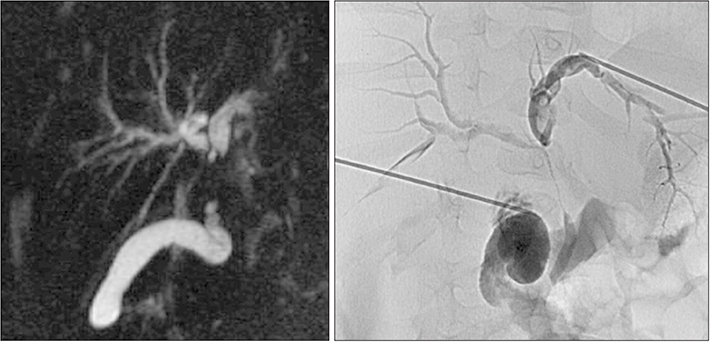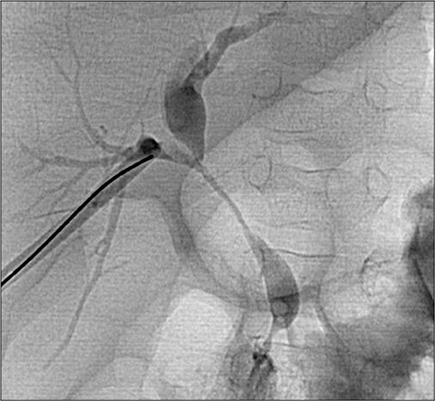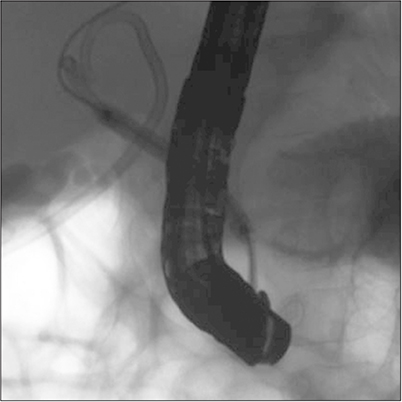Pediatr Gastroenterol Hepatol Nutr.
2019 Nov;22(6):565-570. 10.5223/pghn.2019.22.6.565.
Novel Non-Surgical Interventions for Benign Inflammatory Biliary Strictures in Infants: A Report of Two Cases and Review of Current Pediatric Literature
- Affiliations
-
- 1Division of Pediatric Gastroenterology and Nutrition, Columbia University Medical Center, New York, NY, USA. PR2577@Cumc.columbia.edu
- 2Division of Pediatric Gastroenterology and Nutrition, Children's Hospital at Montefiore, Bronx, NY, USA.
- 3Department of Radiology, Montefiore Medical Center, Bronx, NY, USA.
- 4Department of Medicine, Montefiore Medical Center, Bronx, NY, USA.
- 5Division of Pediatric Surgery, Children's Hospital at Montefiore, Bronx, NY, USA.
- KMID: 2462096
- DOI: http://doi.org/10.5223/pghn.2019.22.6.565
Abstract
- Benign biliary strictures are uncommon in children. Classically, these cases are managed surgically, however less invasive approaches with interventional radiology and or endoscopy may have similar results and improved safety profiles While benign biliary strictures have been described in literature on several occasions in young children, (most older than 1 year and once in an infant 3 months of age), all reported cases were managed surgically. We present two cases of benign biliary strictures in infants less than 6 months of age that were managed successfully with novel non-invasive procedures and a review of all current pediatric cases reported in the literature. Furthermore, we describe the use of a Rendezvous procedure, which has not been reported as a treatment approach for benign biliary strictures.
Keyword
MeSH Terms
Figure
Reference
-
1. Bowles MJ, Salisbury JR, Howard ER. Localized, benign, nontraumatic strictures of the extrahepatic biliary tree in children. Surgery. 2001; 130:55–59.
Article2. Krishna RP, Lal R, Sikora SS, Yachha SK, Pal L. Unusual causes of extrahepatic biliary obstruction in children: a case series with review of literature. Pediatr Surg Int. 2008; 24:183–190.
Article3. Davids PH, Tanka AK, Rauws EA, van Gulik TM, van Leeuwen DJ, de Wit LT, et al. Benign biliary strictures. Surgery or endoscopy? Ann Surg. 1993; 217:237–243.
Article4. Haskal ZJ, Brown RS Jr. Role of biliary stress manometry after biliary stricture dilation in living donor liver transplant recipients. J Vasc Interv Radiol. 2008; 19(2 Pt 1):216–219.
Article5. Standfield NJ, Salisbury JR, Howard ER. Benign non-traumatic inflammatory strictures of the extrahepatic biliary system. Br J Surg. 1989; 76:849–852.
Article6. Amaddeo A, Rubinato E, Schleef J, Olenik D, Giglia D, Marchetti F, et al. Obstructive jaundice in a 3-month-old baby. J Pediatr Gastroenterol Nutr. 2014; 59:e31.
Article7. Negm AA, Petersen C, Schneider A. Rendezvous procedure at 6 weeks of age. Gastrointest Endosc. 2016; 83:670–672. discussion 671-2.
Article
- Full Text Links
- Actions
-
Cited
- CITED
-
- Close
- Share
- Similar articles
-
- Endoscopic Evaluation of Biliary Strictures: Current and Emerging Techniques
- Current Status of Biliary Metal Stents
- Endoscopic Diagnosis and Treatment of Benign Biliary Strictures
- Recent advances of diagnostic approaches for indeterminate biliary tract obstruction
- Complex percutaneous biliary procedures: Review and contributions of a high volume team




